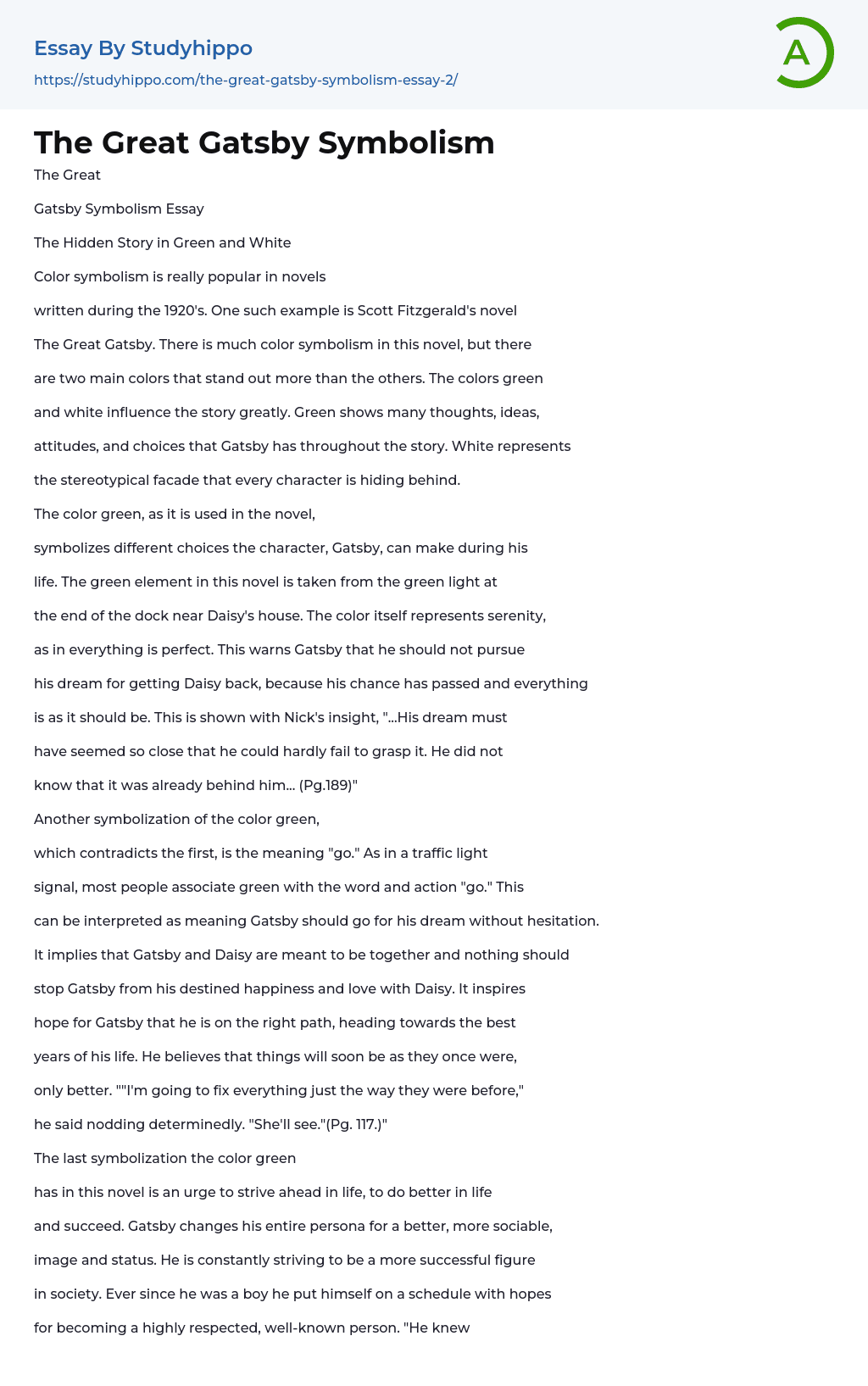In Fitzgerald's novel The Great Gatsby, the use of color symbolism is prevalent, particularly with the colors green and white. These colors have a significant impact on the story, representing various thoughts, ideas, attitudes, and choices that Gatsby encounters throughout the narrative. The inspiration for the green element in the story comes from a green light at the end of a dock near Daisy's house. This light symbolizes serenity and perfection while serving as a warning to Gatsby not to pursue his dream of winning Daisy back because his opportunity has passed. Nick realizes this when he observes that Gatsby's dream seemed within reach but was already behind him. On the other hand, green also represents "go," suggesting that Gatsby should pursue his dream without hesitation, indicating their destined union and nothing should hinder them from f
...inding happiness together.Gatsby finds hope in the belief that he is on the right path towards the best years of his life. He confidently envisions a return to how things were before, only better. "I'm going to fix everything just the way they were before," he declared with determination (Pg.189). The color green symbolizes Gatsby's drive for progress and improvement in life. He undergoes a complete transformation of his persona to present a more socially acceptable image and achieve higher status. Throughout his life, Gatsby had set strict schedules and aspired to be widely recognized and respected. "He knew he had a big future in front of him," his father recalls about Gatsby, stating that he always had such resolves (Pg.117). Alongside green, white is another significant color symbolized in the novel, but its influence extends beyond one character
White represents a facade adopted by various characters like Daisy who consistently dresses in white to maintain an innocent and naive appearance. However, this guise serves as an excuse for her ridiculous and childish behavior while pretending ignorance when she actually knows better.Daisy employs her princess-like image and wealth to conceal her biased, snobbish, and conceited perception of herself and her lifestyle. According to Fitzgerald's description, Tom and Daisy are reckless individuals who destroy without facing consequences, relying on their money or indifference that binds them together. Jordan Baker, another character, also adopts a facade symbolized by the color white. She frequently dresses in white and carries herself with an air of superiority over those around her, evident in her posture, attitude, and remarks. "She reclined completely on her end of the divan while keeping her chin slightly elevated as if balancing something that could easily fall off. If she noticed my presence at all, she gave no indication - I almost felt compelled to apologize for interrupting her (Pg.13)." Her demeanor reflects boredom and apathy towards everything as a deliberate part of maintaining her superior facade. In reality though, she desires the same level of respect and acceptance as Gatsby. Instead of taking responsibility for her actions, she hides behind her image suggesting that she is incapable of any wrongdoing - much like Daisy does. However,"she possessed an inherent dishonesty.She couldn't stand being at a disadvantage so because of this aversion it appears she resorted to deception from an early age to maintain a confident appearance while also fulfilling the desires of her energetic self-assured body."(Pg.63). Though not immediately noticeable, color symbolism has a
crucial role in conveying hidden messages throughout the story. The colors within the text offer insight into the characters' decisions and possible directions, adding layers to the narrative. Green signifies different options open to Gatsby, acting as a cautionary element, a source of motivation, or an inspiration for success. On the other hand, white represents a disguise or front that allows characters to portray themselves as someone else and conceal their real identities. This provides a glimpse of reality since everyone wears metaphorical white masks to hide their true selves. These subtle hints captivate readers and foster a sense of connection with the characters.
- My Dream essays
- My Dream Job essays
- Adaptation essays
- Adventure essays
- Adversity essays
- Aging essays
- Alcohol essays
- Barbie Doll essays
- Beauty essays
- Care essays
- Carpe diem essays
- Change essays
- Chess essays
- Chicken essays
- Choices essays
- Contrast essays
- Crops essays
- Development essays
- Dream essays
- Evil essays
- Experience essays
- Family essays
- Farm essays
- Fire essays
- First Love essays
- Focus essays
- Greed essays
- Hero essays
- Holiday essays
- House essays
- Housing essays
- Humility essays
- Humor essays
- Hypocrisy essays
- Integrity essays
- Law of Life essays
- Life Changing Experience essays
- Life Experience essays
- Lifestyle essays
- Limitations essays
- Love Story essays
- Mother Tongue essays
- Motherhood essays
- My Neighborhood essays
- Myself essays
- Mystery essays
- Narcissism essays
- Never Give Up essays
- Nursing essays
- Object essays




